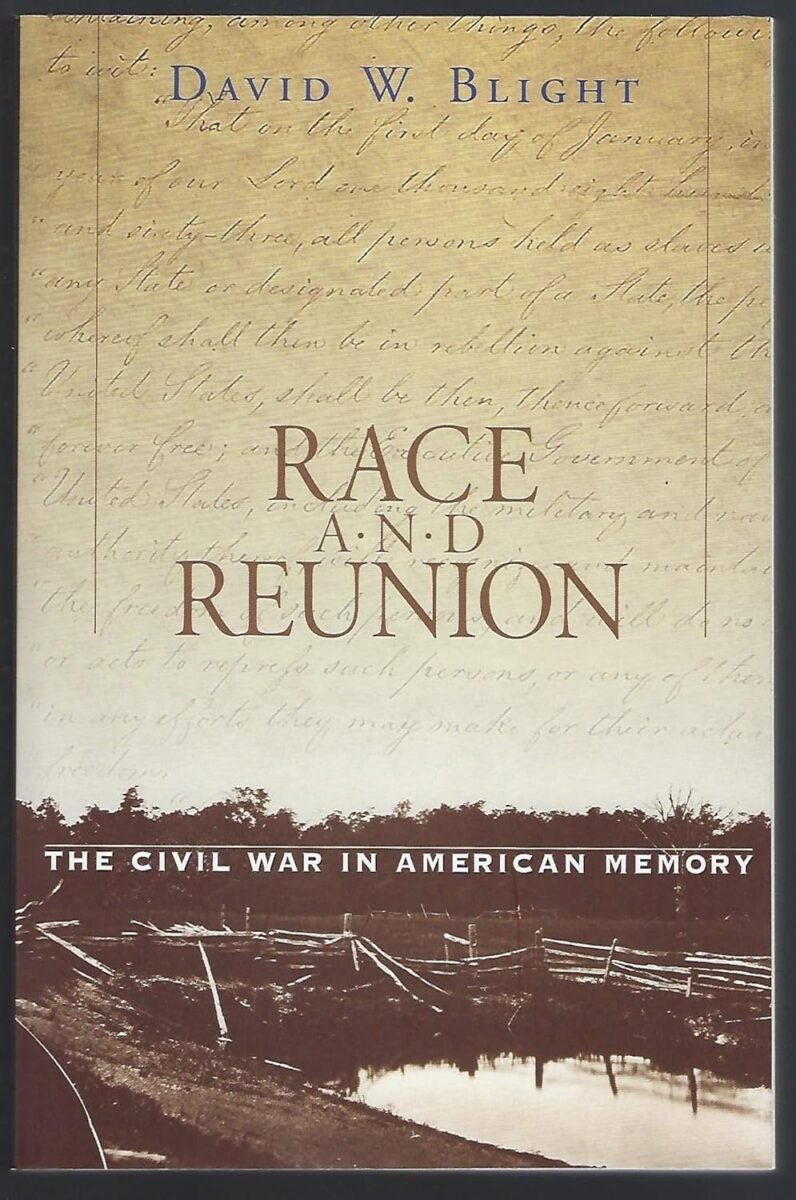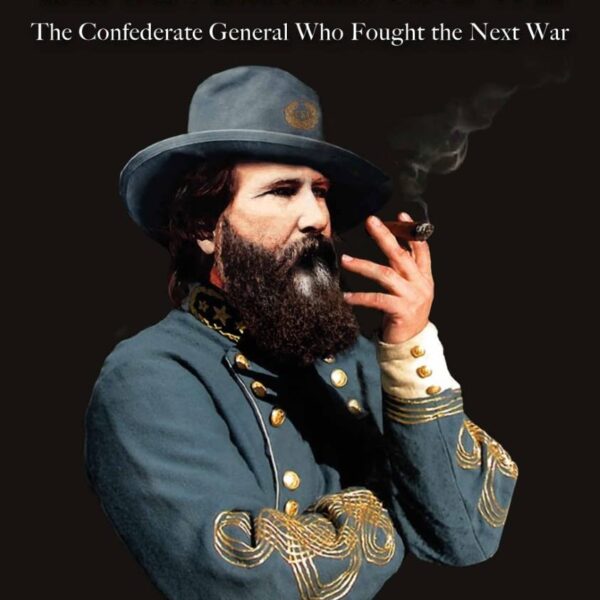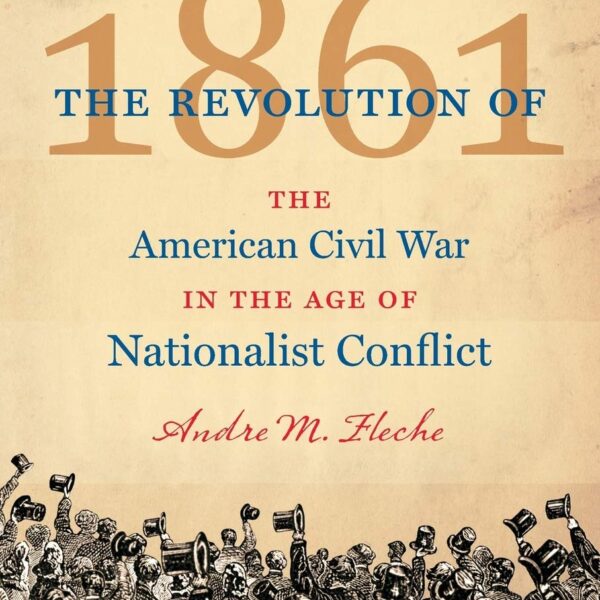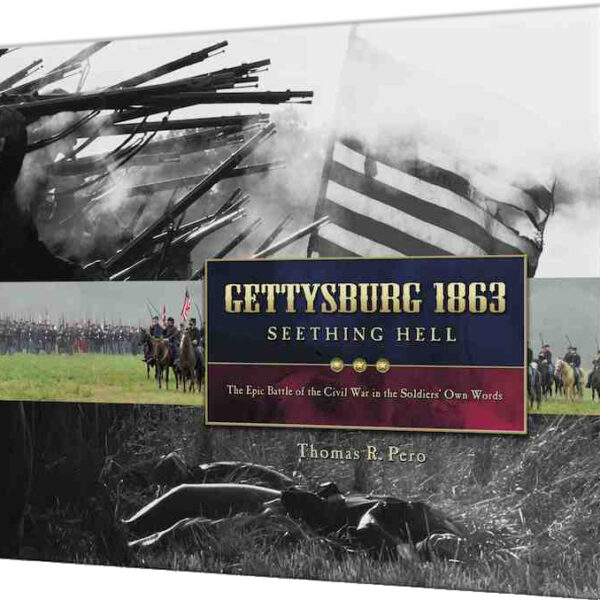There are four copies of David W. Blight’s magisterial Race and Reunion: The Civil War in American Memory on the bookshelves lining my study, each replete with eager (and sometimes skeptical) marginal annotations, and each possessing more than a few tattered, coffee-stained pages—cherished vestiges of many late nights at Gettysburg’s Lincoln Diner. I suspect that I am not alone among the scholars who can recall their first encounter with Race and Reunion. As an innovative blend of intellectual and cultural history, the book forever changed the way that we thought about the Civil War and its shadowy legacy. It was—and remains—one of the most powerful meditations on the interior meaning of the conflict ever to have appeared in print. The book is ambitious, but not unwieldy; far-ranging, yet not comprehensive. Ten years later, I am still grappling with the book’s arguments, its theoretical underpinnings, and its explanatory power.
Even the most cursory survey reveals the profound influence of Race and Reunion on the contours of our mainstream Civil War narrative. Phrases like “purposeful forgetting” and “healing at the expense of justice” are now so firmly entrenched in the lexicon of Civil War studies that it is difficult to remember what the world looked like before Blight. At many battlefield sites across the country, museum panels and wayside exhibits depicting grizzled Union and Confederate veterans clasping hands across the bloody chasm are now standard fare. The National Park Service has adopted the theme of “Civil War to Civil Rights” to steer its sesquicentennial events. At least three popular blogs are devoted to exploring Civil War memory. Campaign and battle studies intended for lay audiences conclude with epilogues devoted to memory, and new regimental histories, such as Salvadore Cilella’s study of the 121st New York, Upton’s Regulars, devote considerable space to reunion activities, monument building, and commemoration. And all of this is to say nothing about the seemingly relentless flood of monographs examining the memory of various Civil War battles, leaders, and events—including, in recent years, Joan Waugh on Ulysses S. Grant; Robert Blakeslee Gilpin on John Brown; Brian Craig Miller on John Bell Hood; John Cimprich and Kevin Levin, respectively, on the massacres at Fort Pillow and at the Crater; Jim Weeks on Gettysburg; Timothy Smith on the Shiloh battlefield; Gabor S. Boritt on the Gettysburg Address; Christian B. Keller on the German memory of Chancellorsville; and Benjamin Cloyd on the atrocities at Andersonville. When Mike Vorenberg reviewed Race and Reunion for the scholarly journal Reviews in American History in 2001, he noted that memory studies had already become something a “boon trade” among Civil War historians. For better or for worse, the “boon trade” has since metastasized into a behemoth conglomerate.
Ten years later, then, it is appropriate to reflect on what we learned from Race and Reunion, as well as what we have learned since. Blight revealed that in the 50 years following Appomattox, sectional reconciliation was about race. To generate national healing, a racially prejudiced North and a formerly slaveholding South needed to cast aside the conflict’s deep, ideological meaning. Notwithstanding the tenacity of “emancipationists,” who dutifully remembered an “abolition” war and sued for an “abolition” peace, “reconciliationists” joined with white supremacists to excise African Americans from the nation’s collective memory of the conflict. The rousing romance of the “brother’s war,” in which mutually heroic Union and Confederate soldiers fought for equally just causes, not only obscured the war’s horrific realities; it stifled the revolutionary potential unleashed by the war for more than a century. Blight lamented that rather than any serious, national introspection, the Civil War resulted in a sentimental sectional reunion that provided fodder for new generations of American exceptionalism. Those tragedies, he pointed out, were proudly on display at the jubilee reunion of blue and gray veterans staged on the Gettysburg battlefield in 1913—a segregated affair that, rather than commemorating a “revolution remembered,” celebrated (in the words of President Woodrow Wilson) “a quarrel forgotten.”
Blight’s narrative of how that quarrel was “forgotten” hardly lacked nuance; he emphasized the contested nature of Civil War memory at nearly every turn, citing the battlefield realism of John W. DeForest and Ambrose Bierce and recalling North Carolina carpetbagger Albion Tourgee’s now well-known admonition that “only fools” forget the cause of war. And, of course, he paid particular attention to the various strands of African-American memories. Nevertheless, it remains difficult to read Race and Reunion as anything but a tale of declension leading inevitably to lily-white Blue-Gray fraternalism. So determined was the book to demonstrate how Americans worshipped the idea of a “brother’s war” and venerated at the altar of the Lost Cause that it ultimately undervalued evidence of lingering sectional acrimony, overestimating the capacity of those on both sides of the Mason-Dixon to forgive and forget. A flurry of new scholarship underlining the deadly, destructive, and “total” character of our fratricidal conflict—including, for example, Drew Gilpin Faust’s This Republic of Suffering and Daniel Sutherland’s A Savage Conflict: The Decisive Role of Guerrillas in the American Civil War—has perhaps made it too difficult for historians to conclude that a war of such staggering magnitude could have been willed away so quickly.
Not surprisingly, then, recent scholars have produced impressive studies challenging our understanding of the extent to which “reconciliationist” and “white supremacist” visions of the war’s memory actually triumphed during the late-nineteenth century. Barbara A. Gannon’s incisive study of the Grand Army of the Republic, The Won Cause, demonstrated that white Union veterans remembered the cause of emancipation and honored the sacrifices of their black comrades. Interracial comradeship, she argued, survived the war unscathed. Studying an impressive array of monument dedication speeches and regimental histories, M. Keith Harris revealed that Union veterans embraced the twin causes of Union and Emancipation throughout the “era of reconciliation.” After all, as Gary W. Gallagher has recently reminded us, these men had gone off to battle in 1861 fighting a war to preserve the Union—a war that only very tortuously became a crusade to end slavery. John R. Neff and William A. Blair have analyzed the “problem” that the staggering number of Civil War dead posed for sectional reunion efforts. Death was the most commonly shared experience of Civil War Americans, and on such an impressive scale, human loss demanded explanation. The northern myth of a victorious Union offered up that justification—and, as Neff argues, in the war’s aftermath, continued to provide the lens through which mass death was interpreted. My own studies of Union amputees and survivors of Confederate prison camps document a strain of Civil War remembrance that Blight’s three organizing categories foreclosed: those who could forgive, but could never forget. The trauma of the Civil War suggests that this vision, of necessity, may have been one of the most common responses to the conflict. Like Neff, I conclude that the war’s losses presented a formidable obstacle to sectional reconciliation; amputees, pensioners, and the wards of the National Home for the Disabled Volunteer Soldier were uncomfortable reminders of the human costs of the war and made the most unconvincing characters in the romance of reunion. Ultimately, I insist that it was not merely the dead, but the living, that challenged the culture amnesia of the late nineteenth century.
As is so often the case with major historical reinterpretations (Robert Wiebe’s The Search for Order, 1877-1920 [1967] and Gordon S. Wood’s The Radicalism of the American Revolution [1992] immediately come to mind) scholars have been so eager either to accept or, conversely, to reject the driving argument of the book that in the process, they have lost sight of its many corollaries. Indeed, historians’ narrow focus on how Americans excised race and slavery from the Civil War story has turned scholarly attention almost entirely away from an equally important set of under-examined questions: the cultural effect of trauma, profound disillusionment, and the extent of lingering doubts on both sides of the Mason-Dixon about what, exactly, the conflict accomplished. To be sure, historians such as Gaines Foster, Michael Kammen, and Nina Silber have variously explored how Civil War memories provided refuge from the glut and glamour of the Gilded Age. But far more often, scholars write as though “Civil War memory” was experienced only in the remote realm of culture, images, and artifacts. Again, for late-nineteenth century Americans, this simply wasn’t the case; “Civil War memory” was a gunshot wound yet marinating in pus; the sensation of a phantom limb; haunting flashbacks to the prison hells of the Confederacy; the vacant stare of a husband transfigured by Shiloh; growing up without a father or a brother; or scraping out a pitiful existence without a husband, pleading with the Pension Bureau for recognition of his sacrifices. Memory was lived experience.
We need a new geography of Civil War memory that destabilizes the boundary too often separating social and cultural history. The real challenge of today’s memory beat, so far as I see it, is not only to perceive the complicated ways in which memory invaded and was contested in the everyday lives of Civil War Americans—to restore to view veterans, widows, and orphans, as well as those who celebrated the preservation of the Union alongside emancipation—but to forge a new interpretation of the Civil War that is deeply rooted in the protracted grappling of generations of Americans with this conflict. This interpretation might once and for all reconcile (pun intended) what the war accomplished with its huge human and emotional cost. Instead of focusing on how the war’s story was segregated, it might focus on how the war’s story was sanitized. One unfortunate (and I think unintended) consequence of the laudable efforts of recent historians to reposition race and slavery at the heart of the conflict is that the Civil War has become the nineteenth-century’s equivalent of “the Good War”—not, as the historian Edward L. Ayers has so eloquently pointed out, a “problem to be explained,” but, rather, a modern-day morality play that we tell and re-tell in an effort to exorcise white guilt. Massive death, destruction, and suffering are effortlessly explained away and left un-interrogated because they contributed to the demise of slavery in America. The blood spilled on battlefields from Big Bethel to Palmito Ranch, we are reassured, cleansed the nation of its collective sin. And as soon as that blood washes away the sin of slavery, that blood is itself washed away. The Civil War, we are told, was a necessary national sacrifice. It is time that we critically examine this sanitizing process and its manifold implications.
But none of this would be possible without the ground that David Blight’s Race and Reunion began to till. The book’s pages will continue to be underlined, annotated, and coffee-stained because the questions it posed were the very questions that Americans have asked themselves again and again, generation after generation. What did the Civil War mean? How can we make sense of such an unprecedented struggle? And, above all, what did that struggle reveal about us as people, and as a nation? In the long shadow of the wars in Iraq and Afghanistan, as scholars once again look askance at the merits of war, the answers to those questions will become even more relevant—and even more uncomfortable. For in the end, as Race and Reunion taught us so well, all memory is but prologue.
Brian Matthew Jordan is a Ph.D. candidate at Yale University and the author of Unholy Sabbath: The Battle of South Mountain in History and Memory, September 14, 1862.





